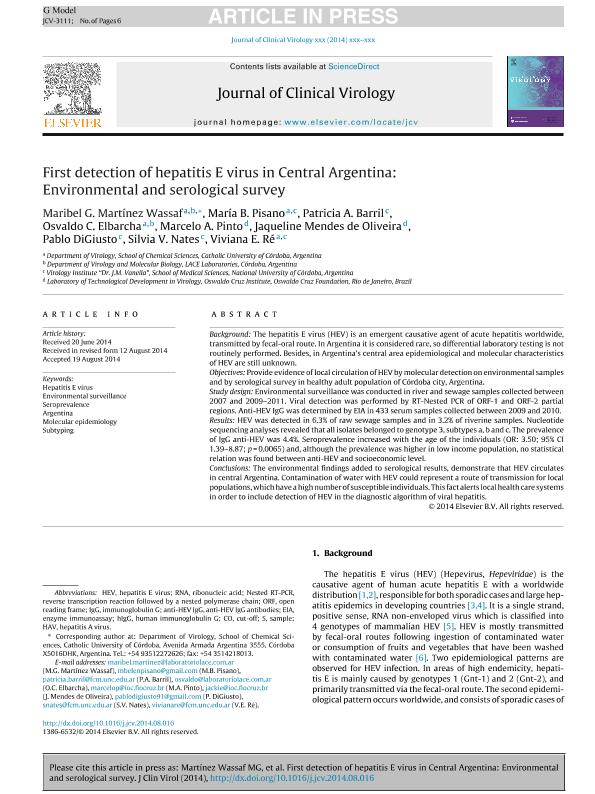Artículo
First detection of hepatitis E virus in Central Argentina: Environmental and serological survey
Martinez Wassaf, Maribel Graciela; Pisano, María Belén ; Barril, Patricia Angelica
; Barril, Patricia Angelica ; Elbarcha, Osvaldo C.; Pinto, Marcelo A.; Oliveira, Jaqueline Mendes de; DiGiusto, Pablo; Nates, Silvia Viviana; Ré, Viviana Elizabeth
; Elbarcha, Osvaldo C.; Pinto, Marcelo A.; Oliveira, Jaqueline Mendes de; DiGiusto, Pablo; Nates, Silvia Viviana; Ré, Viviana Elizabeth
 ; Barril, Patricia Angelica
; Barril, Patricia Angelica ; Elbarcha, Osvaldo C.; Pinto, Marcelo A.; Oliveira, Jaqueline Mendes de; DiGiusto, Pablo; Nates, Silvia Viviana; Ré, Viviana Elizabeth
; Elbarcha, Osvaldo C.; Pinto, Marcelo A.; Oliveira, Jaqueline Mendes de; DiGiusto, Pablo; Nates, Silvia Viviana; Ré, Viviana Elizabeth
Fecha de publicación:
08/2014
Editorial:
Elsevier Science
Revista:
Journal of Clinical Virology
ISSN:
1386-6532
Idioma:
Inglés
Tipo de recurso:
Artículo publicado
Clasificación temática:
Resumen
Background: The hepatitis E virus (HEV) is an emergent causative agent of acute hepatitis worldwide, transmitted by fecal-oral route. In Argentina it is considered rare, so differential laboratory testing is not routinely performed. Besides, in Argentina's central area epidemiological and molecular characteristics of HEV are still unknown. Objectives: Provide evidence of local circulation of HEV by molecular detection on environmental samples and by serological survey in healthy adult population of Córdoba city, Argentina. Study design: Environmental surveillance was conducted in river and sewage samples collected between 2007 and 2009–2011. Viral detection was performed by RT-Nested PCR of ORF-1 and ORF-2 partial regions. Anti-HEV IgG was determined by EIA in 433 serum samples collected between 2009 and 2010. Results: HEV was detected in 6.3% of raw sewage samples and in 3.2% of riverine samples. Nucleotide sequencing analyses revealed that all isolates belonged to genotype 3, subtypes a, b and c. The prevalence of IgG anti-HEV was 4.4%. Seroprevalence increased with the age of the individuals (OR: 3.50; 95% CI 1.39–8.87; p = 0.0065) and, although the prevalence was higher in low income population, no statistical relation was found between anti-HEV and socioeconomic level. Conclusions: The environmental findings added to serological results, demonstrate that HEV circulates in central Argentina. Contamination of water with HEV could represent a route of transmission for local populations, which have a high number of susceptible individuals. This fact alerts local health care systems in order to include detection of HEV in the diagnostic algorithm of viral hepatitis.
Archivos asociados
Licencia
Identificadores
Colecciones
Articulos(CCT - CORDOBA)
Articulos de CTRO.CIENTIFICO TECNOL.CONICET - CORDOBA
Articulos de CTRO.CIENTIFICO TECNOL.CONICET - CORDOBA
Citación
Martinez Wassaf, Maribel Graciela; Pisano, María Belén; Barril, Patricia Angelica; Elbarcha, Osvaldo C.; Pinto, Marcelo A.; et al.; First detection of hepatitis E virus in Central Argentina: Environmental and serological survey; Elsevier Science; Journal of Clinical Virology; 61; 3; 8-2014; 334-339
Compartir
Altmétricas



